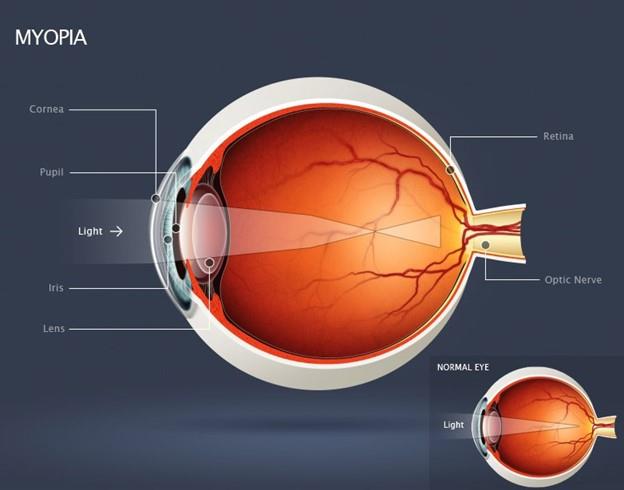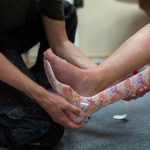Myopia is also called nearsightedness. It’s the condition where you can’t see distant objects clearly. Most prominent when trying to read something a little away from you, myopia progresses over time if not corrected and can become significantly worse.
The worst part? This progression is gradual and you don’t feel anything happening to you at all. It’s only when you test your eyesight or compare it with someone who has better eyesight that you understand the full extent of the problem.
If you suspect you have myopia then you should get an appointment with a leading Chicago eye institute for a proper diagnosis.
We’re going to talk about the causes, treatment, and preventive measures associated with myopia in this guide.
Causes of Myopia
Myopia is caused when the eyeball is slightly longer than normal or when the cornea is too curved. This occurrence causes light rays to resolve slightly in front of the retina instead of directly on it. This, in turn, results in blurry distance vision.
Myopia affects a significant portion of the global population. According to the World Health Organization (WHO), around 30% of the world’s population, or approximately 2.3 billion people, have myopia. The prevalence of myopia has been increasing in recent years, particularly in urban areas and among younger individuals.
Myopia Treatment
Corrective measures for myopia include glasses, contact lenses, and refractive surgery. Most early or mild cases of myopia can be comfortably corrected with glasses or contact lenses. These methods use lenses that compensate for the specific divergence of the light ray’s focus.
Photorefractive keratectomy or PRK is a treatment for myopia. PRK surgery cost is anywhere between $1750 and $3000—Markedly cheaper than LASIK. This laser procedure is a reliable treatment for mild to severe cases of myopia as well as hyperopia (farsightedness) and astigmatism.
- Eyeglasses are the most effective and common way to treat myopia. They help refract light correctly on the retina, providing clear vision for both, near and distant objects. Eyeglasses can also be customized to address specific visual needs such as color blindness, blue light filtering, anti-fogginess, UV protection, and so on.
- Contact lenses are a less in-your-face alternative to eyeglasses. Also, as they sit directly on the surface, they can provide a wider field of view than eyeglasses. Contacts are available as soft lenses, rigid gas permeable lenses, and specialty lenses. Most importantly, you can choose any color for your contact lenses.
- Orthokeratology or Ortho-K is a non-surgical method that uses gas-permeable contact lenses overnight to reshape the cornea. This reshaping corrects myopia, allowing you to have clear vision during the day without having to wear contact lenses or eyeglasses. The effects are reversible, however.
- Refractive surgery is a more permanent option. There are two main surgeries. First of all, you have PRK which we touched upon earlier. LASIK is another option. Both options reshape the cornea in different ways. Though both are considered safe and effective, PRK is generally safer as it doesn’t rely on creating a flap, which can lead to other issues. Rather, it totally removes the outer layer of the cornea (which regrows over time).
Preventive Measures
We looked at the direct treatment options for myopia. Now, let’s look into some measures that people can use to prevent myopia altogether. These measures can also be used alongside treatments like corrective eyeglasses to speed up the recovery process.
- Spend more time outdoors. It’s been linked with a lower risk of myopia development, especially when done during childhood and adolescence. Exposing the eyes to natural light has a protective effect against myopia.
- Take regular breaks from near work. Reading and using electronic devices for long periods strain the eyes, contributing to the progression of myopia.
- Maintain proper lighting when you work. Insufficient lighting can strain the eyes and contribute to eye fatigue. Working in dimly lit environments can also hasten the progression of myopia.
- Practice good visual hygiene. Blink regularly, maintain proper posture, avoid rubbing the eyes, and keep them clean.
- It’s also very important to maintain a comfortable reading distance and position to avoid excessive eye strain. Reading materials or screens should be held at a proper distance, and the font size should be adjusted for comfortable viewing.
Constantly focusing on a close surface (such as a computer screen) can cause permanent reshaping of the cornea. Taking regular breaks and focusing on distant objects (such as trees outside the window) can help maintain the flexibility of the cornea. Follow the 20-20-20 rule—Look at something 20 feet away for 20 seconds every 20 minutes.
Wrapping Up
Myopia is a serious health concern. People with nearsightedness typically have great difficulty in making out objects in the distance. Objects appear fuzzy or out of focus whereas text can be completely unreadable due to the fuzziness.
To compensate for it, it’s not rare for people to unconsciously squint their eyes to improve focus and clarity (it does, to some extent, but isn’t a solution). Prolonged periods of squinting or just attempting to focus on blurry objects and text can cause severe eye strain and headaches. This is further aggravated when you try to focus on electronic devices.
Needless to say, myopia also makes it challenging to read road signs or see distant objects when driving—Compromising safety. If the condition is beyond correction with glasses, PRK myopia might be the only option.




